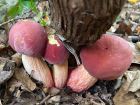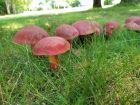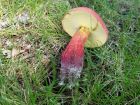Cap convex when young, gradually becoming broadly convex or nearly flat as it matures. The surface is dry and finely velvety when very young, but it soon becomes smooth and bald. At maturity, the texture resembles soft leather, and in older specimens, the surface may develop fine cracks. The colour is usually deep pinkish red to dark brick red, often fading to a lighter reddish or pinkish tone with age. The flesh is pale yellow. Pore surface usually slightly decurrent, running a short distance down the stem, especially in young specimens. It starts out bright yellow, gradually becoming orangish and then dull olive yellow with age, and occasionally reddish in older specimens. When bruised, the pores typically stain blue, often promptly but sometimes more slowly. Stem yellow near the apex, with the lower two-thirds showing red to rosy red colouration. When injured, it bruises blue very slowly and may show little to no colour change in some cases. The stem is solid inside, lacking a ring or any trace of a partial veil. The flesh is deep yellow. Spore print olive-brown.
Microscopic Features: Spores measuring 9–11 × 3.5–5 µm, subfusiform (somewhat spindle-shaped), smooth, and hyaline to yellow or golden in potassium hydroxide (KOH).
Synonyms: Boletus bicolor is an older name for Baorangia bicolor.
Boletus bicolor on the MushroomExpert.Com Web site.
The second photo is by Dave W under the Attribution-ShareAlike 3.0 Unported license.
Many mushrooms are poisonous, and some can be lethally toxic. Distinguishing between edible and poisonous mushrooms can be very challenging. Therefore, we strongly advise against consuming wild mushrooms. This website does not contain any information about the edibility or toxicity of mushrooms.
Although efforts have been made to ensure accuracy on this website, the information may contain errors and omissions. Therefore, all content provided is for educational and informational purposes only and should not be relied upon or used as a basis for consuming any plants or mushrooms.
External links are provided for reference only. We do not endorse or take responsibility for the content, advice, or products found on these sites or in any advertisements shown on this website.




